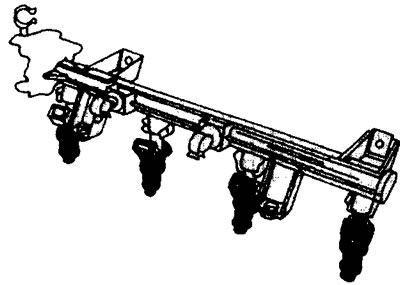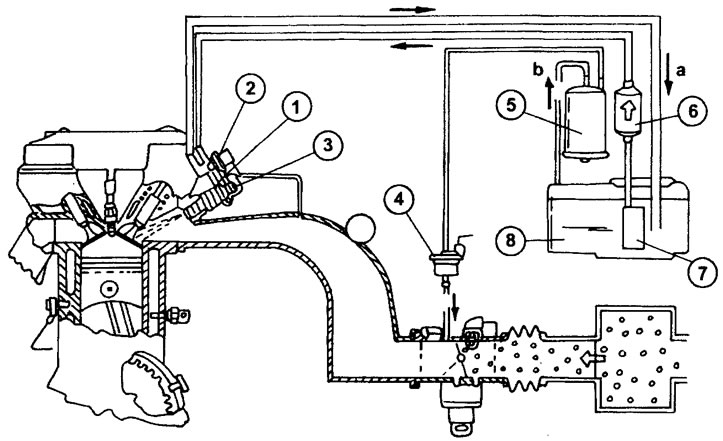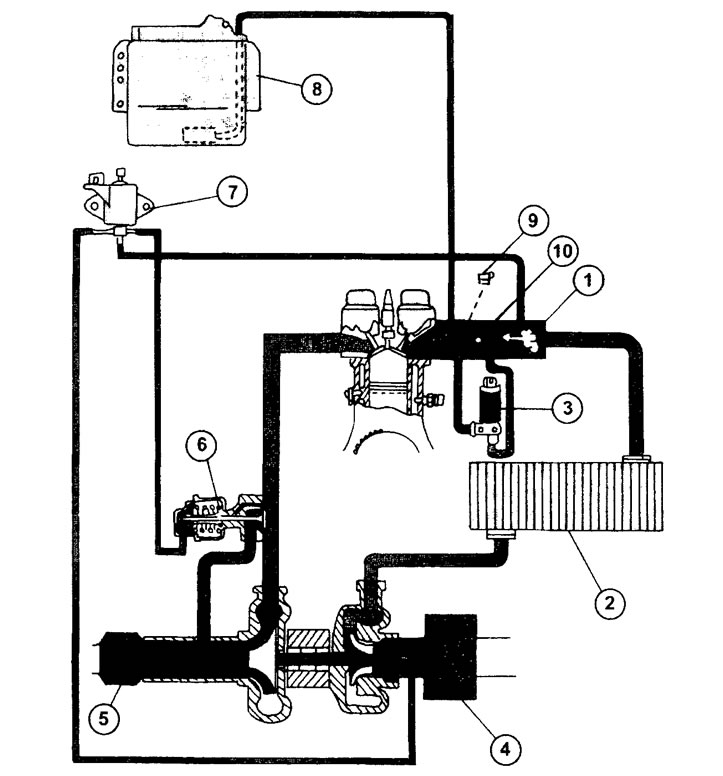Fuel injection system Magnetti Marelli 8Р15. 1.8 liter engine
This multi-point fuel injection system has a static ignition system and is equipped with knock sensors. The ignition timing, as well as the composition of the mixture, is regulated by an electronic control unit. The amount of injected fuel depends on the duration of the fuel injector opening. The duration of the opening of the fuel injector, in turn, depends on the load on the engine, which is recorded by the intake manifold pressure sensor and the crankshaft speed sensor mounted on the flywheel.
All four valve injectors open simultaneously with each engine revolution and inject fuel into the intake manifold. While driving, the injection system control unit makes appropriate adjustments so that the operation of the system matches the operating loads on the engine and track conditions. The functioning of the injection system depends on the information coming from different components of the system. The functioning of the fuel injection system is determined by:
- information about the temperature of the coolant coming from the corresponding sensor;
- information about operating loads on the engine (idling, full load, switching from one mode to another, forced idling), which comes from the TDC and crankshaft speed sensor located on the flywheel;
- atmospheric pressure;
- battery voltage;
- the density of the incoming air, recorded by the intake air temperature sensor;
- information from the lambda probe;
The electronic control unit also regulates the following functions:
- changes the ignition timing and the composition of the air-fuel mixture, based on the data coming from the knock sensor;
- opens the valve for supplying fuel vapor from the adsorber to the intake manifold;
- changes the ignition timing and the supply of additional air volume when the air conditioner is turned on;
- informs the driver with the help of a control light about the occurrence of malfunctions and malfunctions recorded by the self-diagnosis system;
- protects the engine from running at excessive speeds by turning off the ignition;
- informs the driver about the engine speed by monitoring the signals to the tachometer;
- disables fuel injection (followed by inclusion), if the engine speed drops to 1400 rpm;
- corrects the operation of the idle speed regulator drive in the starting and idling phase of the engine.
Information about the pressure in the intake manifold is reported by a sensor located there. At the moment the ignition and starter are turned on, this sensor remembers the atmospheric pressure. This means that when the engine is running, the sensor will inform the electronic unit about changes in pressure in the intake manifold relative to the atmospheric pressure recorded by it. This sensor is powered by 5 V and sends an electrical signal to the control unit, the power of which depends on the pressure in the intake manifold.
The throttle valve angle potentiometer tells the control unit the throttle valve opening angle. This information is needed by the unit to determine the load on the engine. If the accelerator pedal is released, the engine is idling, and the fully depressed accelerator pedal means full engine load. In accordance with the movement of the accelerator pedal, the processes of acceleration and acceleration, braking and switching on forced idling are controlled.
Idling is corrected by the actuator (driven) idle controller. The regulator is located in the throttle body and controls the air supply bypassing the throttle. "This ensures the supply of additional air when the engine is cold, and the idle speed is set depending on the load on the engine and the temperature of the coolant (see illustration 2.0).

2.0 Air intake components for Magnetti Marelli and Bosch MP 5.1 fuel injection systems
1 - intake manifold
2 - resonator box
3 - idle air heater
4 - adsorber solenoid valve
5 - throttle body
6 - idle speed control actuator
7 - air filter
8 - air pressure sensor in the intake manifold
9 - catalyst
The coolant temperature sensor is located in the exhaust pipe, and the intake air temperature sensor is located in the air intake.
The following parts are installed on the throttle body: accelerator cable, fuel pressure regulator, canister valve, secondary air valve, vacuum brake booster, throttle angle potentiometer, idle air heater, intake air temperature sensor and idle air control actuator.
As for the fuel supply, the following should be mentioned as the main details:
- fuel pump. It is installed horizontally in the fuel tank. The pump delivers fuel to the fuel filter.
- fuel filter. It is attached to the fuel tank and must be replaced after the vehicle has driven approximately 80,000 km. There is an arrow on the filter housing which should point towards the front of the engine when the filter is in place.
- adsorber. Fuel vapors generated in the fuel tank are captured by the activated charcoal adsorber. The valve that connects the adsorber to the fuel tank is constantly open when the engine is not running. When the ignition is switched on, the valve closes. When the engine is running, the valve opens according to «requirements» electronic control unit, i.e. upon the occurrence of conditions laid down in the program of operation of the control unit. When the valve is opened, the fuel vapors held in the canister are supplied to the intake manifold.
- fuel pressure reducing valve. The valve is installed on the fuel distribution line. Fuel enters the line from the fuel pump, and the pressure reducing valve maintains a constant pressure in the fuel line of 2.5 bar at idle speed and 3.0 bar at full engine load. Unused fuel is returned to the fuel tank.
- valve injectors. Valve injectors inject fuel and simultaneously spray it directly into the intake manifold. All four injectors fire with every engine revolution (see illustration 2.0a).

2.0а Fuel distribution line for Magnetti Marelli and Bosch MP 5.1 fuel injection systems with injectors. There is a fuel pressure reducing valve on the left side of the fuel line
Fuel injection system Magnetti Marelli 8Р22
This multi-point fuel injection system has a static ignition system and is equipped with knock sensors. The ignition timing, as well as the composition of the mixture, is regulated by an electronic control unit. The amount of injected fuel depends on the duration of the fuel injector opening. The duration of the opening of the fuel injector, in turn, depends on the load on the engine, which is recorded by the intake manifold pressure sensor and the crankshaft speed sensor mounted on the flywheel.
All four valve injectors open simultaneously with each engine revolution and inject fuel into the intake manifold. While driving, the injection system control unit makes appropriate adjustments so that the operation of the system matches the operating loads on the engine and track conditions. The functioning of the injection system depends on the information coming from different components of the system. The functioning of the fuel injection system is determined by:
- information about the temperature of the coolant coming from the corresponding sensor;
- information about operating loads on the engine (idling, full load, switching from one mode to another, forced idling), which comes from the TDC and crankshaft speed sensor located on the flywheel;
- atmospheric pressure;
- battery voltage; - the density of the incoming air, recorded by the intake air temperature sensor;
- information from the lambda probe;
- The electronic control unit also regulates the following functions: - changes the ignition timing and the composition of the air-fuel mixture, based on the data coming from the knock sensor;
- opens the valve for supplying fuel vapor from the adsorber to the intake manifold;
- changes the ignition timing and the supply of additional air volume when the air conditioner is turned on;
- informs the driver with the help of a control light about the occurrence of malfunctions and malfunctions recorded by the self-diagnosis system;
- protects the engine from running at excessive speeds by turning off the ignition at engine speeds of 6500 rpm;
- informs the driver about the engine speed by monitoring the signals to the tachometer;
- disables fuel injection (followed by inclusion), if the engine speed drops to 1400 rpm;
- corrects the operation of the idle speed regulator drive in the starting and idling phase of the engine.
Information about the pressure in the intake manifold is reported by a sensor located there. At the moment the ignition and starter are turned on, this sensor remembers the atmospheric pressure. This means that when the engine is running, the sensor will inform the electronic unit about changes in pressure in the intake manifold relative to the atmospheric pressure recorded by it. This sensor is powered by 5 V and sends an electrical signal to the control unit, the power of which depends on the pressure in the intake manifold.
The following parts are installed on the throttle body: accelerator cable, fuel pressure regulator, canister valve, secondary air valve, vacuum brake booster, throttle angle potentiometer, idle air heater, intake air temperature sensor and idle air control actuator.
The throttle valve angle potentiometer tells the control unit the throttle valve opening angle. This information is needed by the unit to determine the load on the engine. If the accelerator pedal is released. then the engine is idling, and a fully depressed accelerator pedal means full load on the engine. In accordance with the movement of the accelerator pedal, the processes of acceleration and acceleration, braking and switching on forced idling are controlled. Idling is corrected by the actuator (driven) idle controller. The regulator is located in the throttle body and controls the air supply bypassing the throttle. This ensures the supply of additional air when the engine is cold, and the idle speed is set depending on the load on the engine and the temperature of the coolant.
The coolant temperature sensor is located in the exhaust pipe, and the intake air temperature sensor is located in the air intake.
The air supply to the cylinders is controlled by a throttle valve (see illustration 2.0).
As for the fuel supply, the following should be mentioned as the main details:
- fuel pump. It is installed horizontally in the fuel tank. The pump delivers fuel to the fuel filter.
- fuel filter. It is attached to the fuel tank and must be replaced after the vehicle has driven approximately 80,000 km. There is an arrow on the filter housing which should point towards the front of the engine when the filter is in place.
- adsorber. Fuel vapors generated in the fuel tank are captured by the activated charcoal adsorber. The valve, by which the adsorber is connected to the fuel tank, is constantly open when the engine is not running. When the ignition is switched on, the valve closes. When the engine is running, the valve opens according to «requirements» electronic unit at the board, i.e. upon the occurrence of conditions laid down in the program of operation of the control unit. When the valve is opened, the fuel vapors held in the canister are supplied to the intake manifold.
- fuel pressure reducing valve. The valve is installed on the fuel distribution line. Fuel enters the line from the fuel pump, and the pressure reducing valve maintains a constant pressure in the fuel line of 2.5 bar when the engine is idling and 3.0 bar at full engine load. Unused fuel is returned to the fuel tank.
- valve injectors. Valve injectors inject fuel and simultaneously spray it directly into the intake manifold. All four injectors fire with every engine revolution (see illustration 2.0b).

2.0b Details of the fuel supply of the Magnetti Marelli fuel injection system. letter «A» the direction of fuel supply from the tank is indicated, and the letter «b» - fuel return to the tank.
1 - distribution fuel line
2 - fuel pressure reducing valve
3 - valve nozzle
4 - adsorber solenoid valve
5 - container with activated carbon
6 - fuel filter
7 - fuel pump in the tank
8 - fuel tank
Fuel injection system Bosch MP 5.1 Motronic
This system is installed on engines of 1.8 liters. Like the already mentioned Magnetti Marelli injection system, in the Motronic system the main information is also about the engine load, which is recorded by the intake manifold pressure sensor, and information from the crankshaft speed sensor mounted on the flywheel (see also illustration 1.0a). The main components of the Motronic are identical to the Magnetti Marelli injection system.
Bosch MP 3.2 fuel injection system
This system is equipped with a 2.0-liter engine with 8 valves and a gas turbine supercharger. In general, the system is identical to Magnetti Marelli, but it also has certain differences (see illustration 2.0c).

2.0v Air intake components on a turbocharged engine
1 - intake manifold
2 - boost air cooler (intercooler)
3 - idle adjustment valve
4 - air filter
5 - catalyst
6 - control valve
7 - gas turbine supercharger control valve
8 - electronic control unit with pressure sensor in the intake manifold
9 - air heater on the throttle body
10 - throttle body
Valve injectors are installed on the fuel distribution line. They are controlled by an electronic control unit and each separately inject fuel into the valve of its cylinder with each engine revolution.
The fuel pressure regulator is located on the fuel distribution line and maintains a constant fuel pressure of 3.0 bar under all engine loads.
The intake manifold has air intake channels with variable length and internal diameter, which allows you to increase torque at low engine speeds.
The electronic control unit interrupts the fuel supply during forced idling with engine speeds less than 1280 rpm and turns it on after the engine speed increases.
To protect the engine from running at excessive speeds, the electronic control unit turns off fuel injection at 6840 rpm. The TDC sensor for the cylinder pistons is mounted on the cylinder head.
Bosch MP 7.3 fuel injection system
This fuel injection system is equipped with engines of 2.0 liters with 16 valves. In general, its components are identical to the Bosch MP 3.2 system. The system itself is a sequential fuel injection system.
Idling and CO content
As already mentioned, idling for engines with the indicated fuel injection systems cannot be adjusted. The stability of the idle speed is ensured by the electronic control unit, which, using the idle speed controller drive, maintains the idle speed at the level of the nominal values. The allowable deviation can be±50 rpm, which does not affect the operation of the engine.
The content of CO in the exhaust gases is automatically kept at a predetermined level of approximately 0.5% using a lambda probe.
